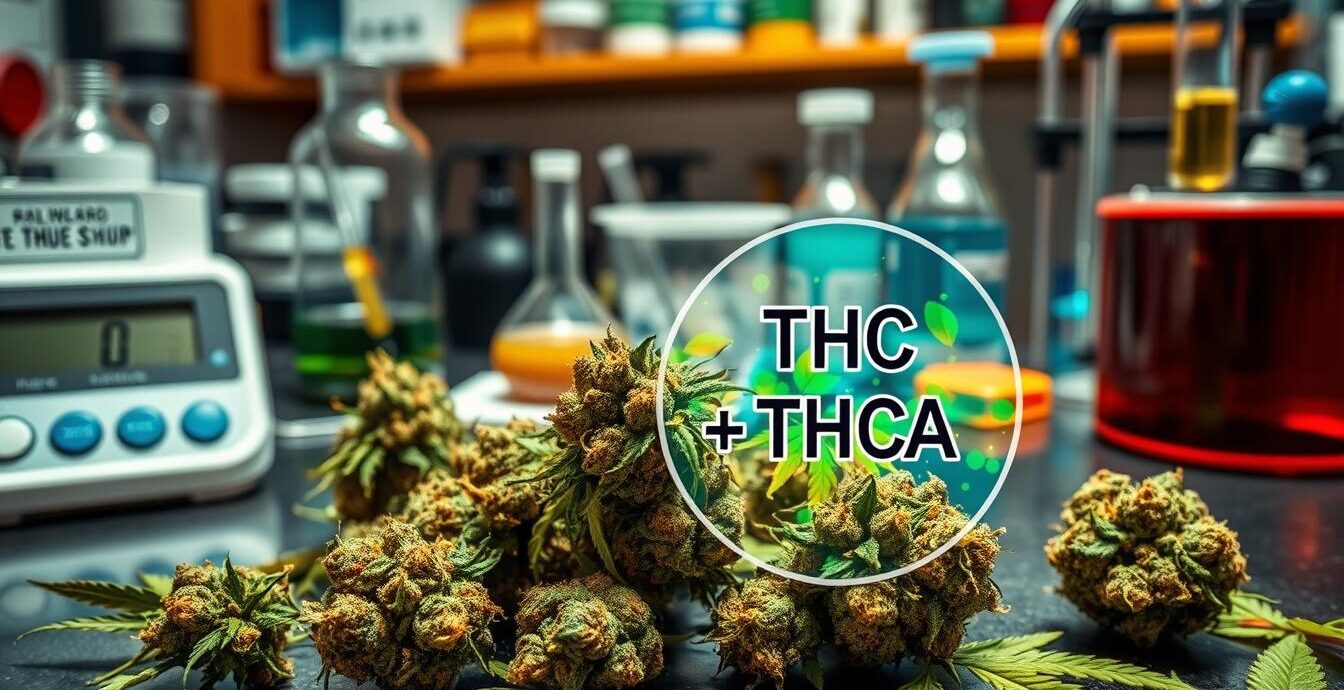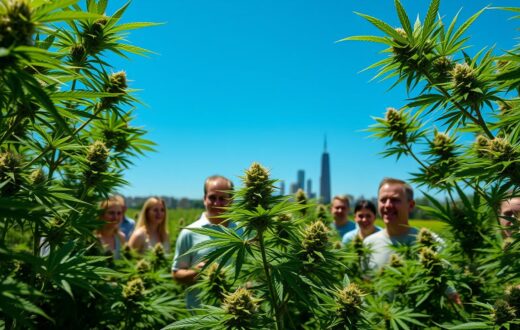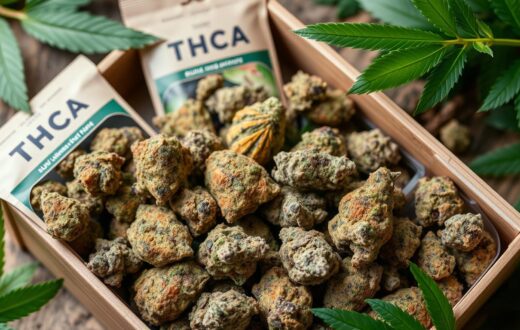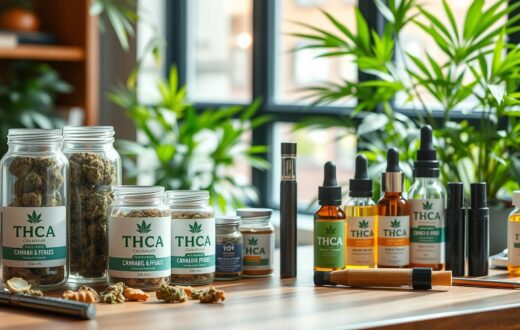Ever wondered why your cannabis experience can vary so dramatically from strain to strain? The secret might just lie in a compound you’ve never heard of: THCA. But how do we measure this elusive cannabinoid, and why does it matter?
THCA, or tetrahydrocannabinolic acid, is the non-psychoactive precursor to THC in cannabis. It’s crucial to understand THCA content because it directly impacts the potency of your cannabis. When heated, THCA converts to THC, the compound responsible for the “high” feeling.
Measuring THCA isn’t just for lab coats and scientists. Whether you’re a casual user or a cannabis connoisseur, knowing how to measure THCA can help you make informed choices about your cannabis products. From professional lab testing to at-home kits, there are various THCA testing methods available.
Did you know that THCA converts to THC at a rate of about 87.7%? This means for every gram of THCA, you’ll get roughly 0.877 grams of THC after heating. Understanding this conversion is key to calculating total THC content, which is often done using the formula: Total THC = THC + (THCA × 0.877).
In this guide, we’ll explore different THCA analysis techniques, from high-tech lab equipment to DIY methods for the curious cannabis enthusiast. We’ll break down the science, discuss the pros and cons of various testing methods, and help you understand what those numbers on your cannabis label really mean.
Ready to dive into the world of THCA measurement? Let’s get started on this journey to becoming a more informed cannabis consumer!
Understanding THCA: The Basics
THCA stands for tetrahydrocannabinolic acid. It’s a key part of raw cannabis plants. There are over 100 cannabinoids in hemp and cannabis, and THCA is one of them. Unlike THC, THCA doesn’t make you high. But it’s still important for testing cannabis potency.
What is THCA?
THCA is the precursor to THC, the compound that causes marijuana’s psychoactive effects. It’s found in fresh cannabis. When heated, THCA turns into THC. This process is called decarboxylation. Understanding THCA is key to knowing a plant’s potential potency.
Differences Between THCA and THC
The main difference is their effect on the body. THCA is non-psychoactive, meaning it won’t make you feel high. THC, on the other hand, is what gives marijuana its intoxicating properties. THCA has a slightly different molecular structure, with an extra carboxylic acid group.
Importance of Measuring THCA
Measuring THCA is vital for several reasons. It helps predict the potential THC content after decarboxylation. This information is crucial for dosing in medical applications. It’s also important for legal compliance, as hemp must contain less than 0.3% THC. Accurate cannabis potency testing ensures product quality and safety for consumers.
Common Methods to Measure THCA
Marijuana potency analysis is key to understanding cannabis products. We’ll look at different ways to measure THCA, from lab tests to DIY methods.
Laboratory Testing Techniques
Professional labs give the most accurate results. They use top-notch equipment to measure THCA levels. These tests give detailed reports on cannabinoid content, ensuring product safety and quality.
At-Home Testing Kits
At-home kits offer quick results. They’re a handy way to estimate THCA levels. While not as precise as lab tests, they’re a cost-effective option for enthusiasts and small-scale growers.
DIY Methods for Enthusiasts
Some cannabis fans try DIY methods for measuring THCA. These methods often involve simple chemical reactions. They’re budget-friendly but less accurate than professional tests. It’s important to note that 93% of smokable hemp samples tested had total Δ9-THC values above the federal limit, highlighting the need for reliable testing methods.
Each method for marijuana potency analysis has its pros and cons. Lab tests are precise but more expensive. Home kits give quick results but may not be as accurate. DIY methods are fun but need caution. Choose the method that best fits your needs and expertise level.
Laboratory Testing Explained
Cannabis lab testing uses advanced methods to measure cannabinoid content. These techniques give accurate results for medical and recreational products. Let’s look at the main approaches used in professional labs.
Gas Chromatography
Gas chromatography for thca is a common method. It separates compounds by boiling points. This method works well for many cannabis products but has limits with edibles. That’s why some labs now prefer liquid chromatography for a wider range of items.
High-Performance Liquid Chromatography
HPLC is another key tool in cannabis lab testing. It uses liquid solvents to separate compounds. This method can measure both THCA and THC levels separately. It’s great for edibles and gives a clear picture of a product’s potency.
Mass Spectrometry
Mass spectrometry often pairs with chromatography methods. It identifies molecules by their mass and charge. This combo provides detailed info about cannabinoids and terpenes. It’s crucial for creating complete lab reports that show product quality and safety.
These lab techniques help calculate total THC content. The formula is: THCtotal = (%THCA) x 0.877 + (%THC). This info is vital for consumers and regulators alike. It ensures products meet legal standards and helps users understand what they’re buying.
At-Home Testing Kits: Pros and Cons
At-home testing kits are popular for those who want to test cannabis potency themselves. They allow you to check cannabis strength without expensive lab gear. Let’s look at the good and bad sides of using these kits.
Accuracy of Home Kits
Home thca measurement kits are easy to use but might not be as accurate. Labs use advanced methods like gas chromatography for precise results. Home kits often use simpler methods like colorimetric or thin-layer chromatography, which might not be as reliable.
Ease of Use
At-home testing kits are simple to use. They usually come with easy-to-follow instructions and don’t require much science knowledge. This makes them great for both curious beginners and medical cannabis users who want to check their medicine’s strength.
Cost Considerations
Home cannabis potency test kits are cheaper than lab tests. Prices vary, but they’re much less expensive. For those who test often, these kits can save money. However, they might not be as accurate as lab results.
DIY Methods: What You Need to Know
Ever wondered about thca extraction techniques? Trying DIY cannabis analysis can be a fun learning experience. But, it comes with its own set of challenges. Let’s dive into the world of homemade thca tests and what they mean.
Extracting THCA for Testing
THCA extraction begins with raw cannabis. Solvents like ethanol or CO2 are used to pull out THCA from the plant. This step needs careful handling and safety measures. The aim is to get THCA, which doesn’t get you high until it’s heated.
Simple Chemical Reactions
After extraction, DIY cannabis analysis often uses basic chemical tests. These might show color changes or simple chromatography. While these tests can hint at THCA presence, they don’t give exact amounts like lab tests do.
Limitations and Risks
Homemade THCA tests have big downsides. They’re not as accurate as professional lab tools and can be risky if not done right. DIY methods are better for learning, not for precise potency or safety checks. Always put safety first and think about legal issues before trying any extraction or testing at home.
Understanding Lab Results
Cannabis lab reports are key to knowing the strength and quality of products. They might seem hard to understand at first. But, it’s vital for making smart choices. Let’s look at the main parts of these reports and how to read them well.
Reading THCA Test Results
THCA test results are a big part of lab reports. They show how much THCA is in the sample. Flowers usually have 15-30% THCA, while edibles have 5-15%.
These numbers tell us how much THC we might get after the product is made.
Other Cannabinoid Measurements
Lab reports also show CBD, CBG, and other cannabinoids. These work together to create the entourage effect. For example, an edible might have 2 mg THC and 3 mg CBD.
Knowing the whole profile helps us guess how the product will affect us.
Factors Affecting Results
Many things can change THCA test results. The strain, growing conditions, and how the product is made after harvest all matter. Things like light, nutrients, and curing methods also play a role.
The method used to test, like HPLC or GC, can also change the results. Remember these factors when looking at lab reports.
Regulatory Standards in Measurement
Cannabis testing rules change from state to state. It’s key for labs to keep up. The National Institute of Standards and Technology (NIST) has a Hemp Plant Reference Material. It helps labs measure THC content right.
This material has exact amounts of THC, CBD, and more. Labs can check their work for hemp and marijuana.
State Requirements for Testing
Thirty-seven states allow medical marijuana, and 19 let people use it for fun. Each place has its own rules for testing. The Farm Bill says hemp has less than 0.3% THC.
Labs must report THC levels on a dry-weight basis. This meets most state limits.
Importance of Certified Labs
Certified labs are key for safe products and right labels. They use advanced methods like Gas Chromatography-Mass Spectrometry (GC-MS). And Direct Analysis in Real Time-High Resolution Mass Spectrometry (DART-HRMS).
These methods help tell hemp from marijuana. They help everyone from regulators to consumers.
Quality Assurance Practices
Labs work hard to keep standards high. They do studies and look for better ways to measure cannabinoids. They use reference materials and check their methods.
They also explore new tech like THC breathalyzers. Their goal is to make testing faster, cheaper, and more accurate.
Impact of THCA on Cannabis Potency
THCA is crucial for cannabis potency. It’s the main compound in raw cannabis. When heated, it turns into THC, which is key for understanding thca vs thc potency.
How THCA Affects Medical Use
The thca medical benefits are getting more attention. THCA might help with inflammation and protect nerves without making you feel high. Some people eat raw cannabis or use THCA products to get these benefits.
Presence of THCA in Different Strains
Strain-specific thca content varies a lot. Some THCA flowers can have up to 40% THCA. This is much higher than the THC levels in regular cannabis. Each strain has its own THCA profile, which affects its potential uses.
THCA and Psychoactivity
THCA itself doesn’t make you feel high. It needs heat to change into THC, which does cause psychoactive effects. About 87.7% of THCA turns into THC when heated. This means a strain with 36% THCA could end up with around 31.5% THC after heating.
Storage and Preparation Best Practices
Keeping cannabis samples in good condition is key for accurate tests. We’ll look at how to keep samples right and get them ready for testing.
Maintaining Sample Integrity
To keep THCA levels high, store cannabis in cool, dark spots. The best spot is where it’s below 70°F and not too humid. This helps keep THCA levels steady.
Ideal Storage Conditions
For the best THCA preservation, use airtight containers or vacuum-sealed bags. These keep out light and moisture, which can lower THCA levels. Some growers even freeze their crops right away to keep THCA levels up.
Preparing Samples for Testing
When getting samples ready for tests, make sure to grind them evenly. Use clean tools and surfaces to avoid contamination. For THCA concentrates, careful handling is crucial to keep them pure. Labs might use special methods to extract THCA before testing.
Good storage and preparation are vital for accurate test results. By following these tips, you help make testing in the cannabis world more reliable and consistent.
Importance of Accurate Measurement
Getting THCA measurements right is key in the cannabis world. It affects how much people pay, what they get, and the market’s direction. Knowing the potency of cannabis is crucial for users to enjoy what they buy.
Implications for Consumers
For those who use cannabis, knowing the THCA levels is very important. With a 13% average error in measuring THCA, it’s hard to know what you’re getting. But, with accurate numbers, users can use the right amount and know what they’re in for.
Effects on Pricing and Market Trends
THCA levels shape the cannabis market. Most cannabis, 87.5%, has a lot of THCA, which changes prices. Using methods like LC-MS for testing helps set fair prices based on how strong the cannabis is.
Traceability and Compliance
Accurate THCA measurements are also about following the rules and keeping track of products. The European Commission has rules for THC levels in hemp products. Testing by outside labs makes sure products are safe and follow the law. This helps the cannabis industry grow in a responsible way.
Innovations in THCA Measurement
The cannabis industry is growing fast with new ways to test THCA. New technologies are changing how we check this key compound in cannabis plants.
Emerging Technologies
Portable spectrometers and quick testing devices are making it easier to test THCA on-site. These tools let growers and dispensaries check THCA levels fast and simple. Cannabis testing tech is getting easier to use, helping even small places do accurate tests.
Future Trends in Cannabis Testing
The future of cannabis testing is exciting. We’re moving towards automated and precise ways to measure. High-Performance Liquid Chromatography (HPLC) and Gas Chromatography (GC) are getting faster and more accurate.
These updates will help keep quality consistent across different cannabis types and products.
Role of Artificial Intelligence
AI in THCA measurement is a big deal. Machine learning can understand complex data from cannabis samples. It finds patterns and predicts results.
This tech makes THCA analysis faster and more accurate. It could change quality control in the cannabis world. As AI grows, we’ll see more cool uses in cannabis testing.
Conclusion: Making Informed Choices
As we finish our thca measurement guide, it’s clear that knowing about THCA is key. It’s important for both those who use cannabis and those who make it. There are many ways to check cannabis’s strength and effects. Let’s look at some important points and find more resources.
Recap of Key Points
THCA flower is grown to keep more THCA. It has a good mix of cannabinoids and doesn’t get you high. It might help with inflammation and stress.
But, THCA loses its special properties when heated. So, it’s best to eat it raw, like in juices or smoothies. Good cannabis looks vibrant, smells strong, and feels sticky.
Resources for Further Information
If you want to choose cannabis wisely, you need good testing resources. Look at trusted research places, government health sites, and certified labs. They offer the latest on THCA’s benefits, laws, and new discoveries.
Final Thoughts on Measuring THCA
Measuring THCA is not just about how strong it is. It’s about seeing the plant’s full potential. As the cannabis world grows, knowing about THCA helps us make smart choices.
If you’re looking into THCA for health reasons or just curious about cannabis, learning is key. Always keep learning, stay curious, and always put safety first in your cannabis journey.















